Micro Inverter Manufacturer
Say goodbye to shading or panel mismatch issues. With advanced monitoring and enhanced safety features, our micro inverters revolutionize your solar system. Embrace clean, sustainable energy and unlock the full potential of the sun.
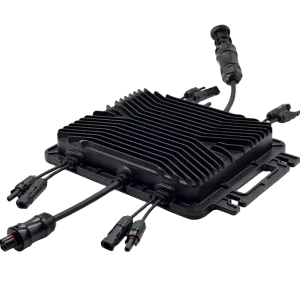
Micro Inverters
Established in 2018, HIITIO is a manufacturer that specializes in solar energy systems.
We also are a leading supplier of micro inverters which are all built to deliver safety and stability you can count on.
HIITIO offers micro inverters ranging from 300W to 2000W, and it comes with different output voltages 120V/230V. It supports multiple communication methods WIFI/Mobile APP/PC Browser. And with cloud monitoring, you can spot the signs of a potential problem sooner – and keep your property safe, 24/7.
How to Install PV Micro Inverters
-
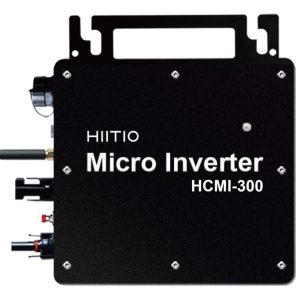
300W PV Micro inverter
$99.00 -
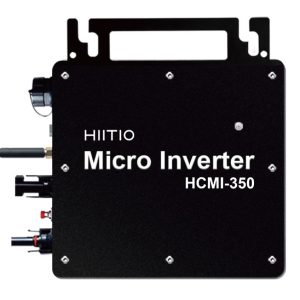
350W PV Micro inverter
$99.00 -
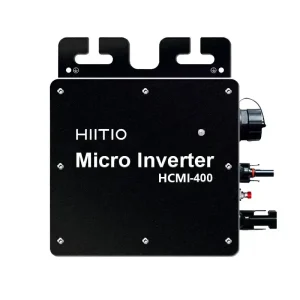
400W PV Micro Inverter
$99.00 -
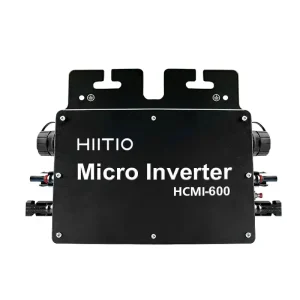
600W PV Micro inverter
$99.00 -
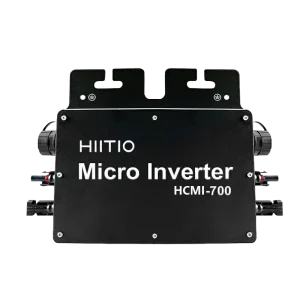
700W PV Micro inverter
$99.00 -
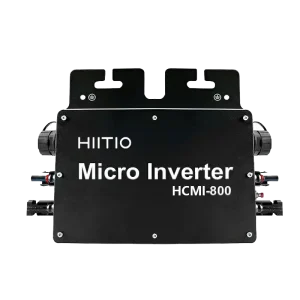
800W PV Micro inverter
$99.00 -
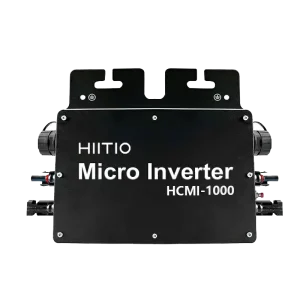
1000W PV Micro inverter
$99.00 -
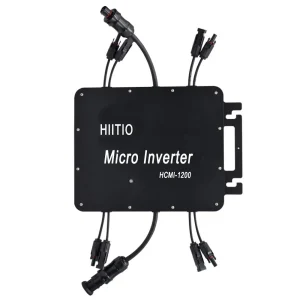
1200W PV Micro inverter
$99.00 -
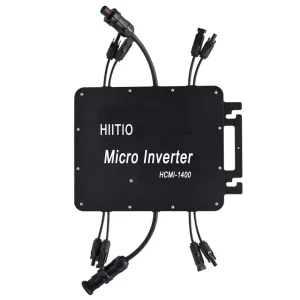
1400W PV Micro inverter
$99.00 -
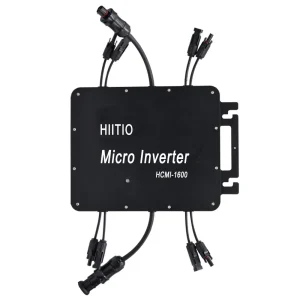
1600W PV Micro inverter
$99.00 -
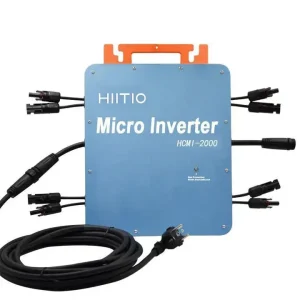
2000W PV Micro inverter
$99.00
Features of HIITIO Micro Inverters
Efficient conversion guaranteed
Converting energy from DC to AC doesn’t have to create huge levels of waste. Our micro inverters come backed by up to 95% peak efficiency – so you can optimize your use of solar and get more from your installation.
Solar that starts when you do
With low start voltages, your production happens from sunrise to sunset.
Energy made effortless
With real-time monitoring, see how your system is performing and make changes, anywhere in the world. And get a 12-year warranty as standard and options to extend it to up to 25 years.
Get always-on solar energy
Micro inverters realize the true potential of solar by giving you seamless, always-available performance. If one module fails or runs into issues, the rest of your system stays up and running at peak performance.
Optimal performance for every module
Whatever the size of your solar system, panels aren’t working in identical conditions. Only micro inverters with outstanding module-level MPPT can adapt to these conditions, even as they change throughout the day. With Hiitio, make sure every panel is performing at its best, increasing your power yield and reducing the time it takes to recoup your costs.
Why HIITIO
19
Years of experience
50+
Countries & Areas
200+
Employees
30,000
㎡ Headquarters
Reliable Quality
Unmatched reliability, adaptable performance, and peace of mind in safeguarding your electrical systems.
Low MOQ
Low Minimum Order Quantity from 100 Pcs to make it easier for you to access our products.
Fast Delivery
Implement streamlined processes and logistics to ensure that your orders are delivered promptly.
Factory Capability
Dedicated team of 200+ staff with peak efficiency, seamless coordination, and unmatched quality control.
Perfect Service
We deliver a comprehensive service package, guaranteeing your satisfaction, safety, and ongoing support.
All you should know about Micro Inverters
What is a micro inverter?
A micro inverter is a device that connects to a single solar panel, converting DC from the panel into AC , which can power household appliances or be sent into the grid for energy credits. They are part of the Module-Level Power Electronics (MLPE) family – a technology that maximizes your PV system by boosting the Maximum Power Point Tracking (MPPT) in each module independently.
Homeowners and installers have different options available when designing a PV system. The National Renewable Energy Laboratory (NREL) says that the MLPE is gaining a market share of 55% at a residential level. Unlike string inverters, micro inverters control the output of a single panel, it makes the output power of each module independent of the performance limitations of the others.
When to use the Micro inverter?
Shaded or Partially Shaded Installations:
Micro inverters are well-suited for installations where solar panels may experience shading or partial shading throughout the day. Since each panel operates with its own micro inverter, shading on one panel does not significantly impact the performance of the entire system.
Complex Roof Orientations:
If your roof has multiple orientations or different sections with varying sun exposure, micro inverters can maximize energy production by allowing each panel to operate independently. This is in contrast to string inverters, which may be limited by the performance of the least productive panel in a series.
Panel-Level Monitoring:
Micro inverters offer the advantage of panel-level monitoring, allowing you to track the performance of each individual solar panel. This level of monitoring can help identify any issues or inefficiencies in specific panels, enabling more effective maintenance and troubleshooting.
System Flexibility and Scalability:
Micro inverters provide flexibility for system design and expansion. They allow for easy addition of panels without requiring major modifications to the existing setup, making them suitable for installations that may require future expansion.
Safety Considerations:
Micro inverters operate at lower DC voltages compared to string inverters, which can enhance safety during installation, maintenance, and firefighting scenarios.
Aesthetics:
Micro inverters can be visually appealing for certain installations since they eliminate the need for a centralized inverter, which can be bulky and require additional space.
How does a Micro inverter work?
Micro inverters convert electricity from each solar panel onsite to AC before sending it to the fuse box and electric grid. They help maintain your total output, even when one panel is shaded. Your solar panel system will be more efficient with micro inverters.
When solar modules are wired together and fed to a single inverter, the solar energy output will depend on the worst-performing panel.
This is the case with traditional string inverter systems, as the panels are all grouped in a set.
With micro inverters placed behind each panel in your solar array, a malfunctioning panel does not affect your total output.
That’s because every single panel operates independently with its own micro inverter.
A solar inverter works by taking in the variable direct current from the solar panels and transforming it into alternating 120V/240V current or ‘AC’ output. The appliances in your home operate on AC rather than DC. Therefore, the solar inverter plays a crucial role in converting the DC output generated by your solar panels into AC power that can be utilized by your household appliances.
Technically, the sun shines down on your solar panels (photovoltaic cells), which are composed of semiconductor layers of crystalline silicon. These layers are a combination of both positive and negative layers, which are connected by a junction.
When the sun shines, the semiconductor layers absorb the light and transfer the energy to the PV cell. This energy runs around and bumps electrons lose, and they move between the positive and negative layers, generating an electric current called direct current. Once this energy is produced, it is either stored in a battery for later use or sent directly to an inverter. This ultimately depends on the solar inverter system you have.
When the energy gets sent to the inverter, it is usually in DC format. However, your home requires an alternate current. The inverter grabs the energy and runs it via a transformer, which then spits out an AC output. In brief, the inverter operates by rapidly switching on and off two or more transistors, effectively controlling the flow of direct current. This controlled current is then directed to the transformer’s two different sides, resulting in varying electrical outputs.
What kinds of solar systems are compatible with Micro Inverters?
You may want to consider solar micro inverters if:
- You have a complex solar installation, such as panels facing different directions or at varying angles
- There is marginal shading in the area where your panels will be mounted
- You want to maximize efficiency
- You’re interested in the ability to monitor each panel’s health and production independently
Can Micro inverters be used with Optimizers?
Micro inverters can be used in conjunction with optimizers in certain solar PV systems. This combination is often referred to as an AC module system. In this setup, each solar panel is equipped with both a micro inverter and an optimizer.
The optimizers are installed at the module level and perform several functions. They maximize the energy harvest from each individual solar panel by performing MPPT (Maximum Power Point Tracking) at the module level, ensuring that each panel operates at its maximum power output. Optimizers also provide module-level monitoring, allowing for detailed performance analysis and fault detection.
The micro inverters, on the other hand, convert the DC power produced by each solar panel into AC power. Each micro inverter operates independently, so shading or issues with one panel do not significantly impact the performance of the entire system.
By combining micro inverters with optimizers, AC module systems can offer enhanced energy production, system monitoring, and fault detection capabilities. This configuration is particularly useful in installations with shading, complex roof orientations, or varying panel conditions.
Does the micro inverter include a rapid shutdown device, and can it be installed with a rapid shutdown? Or do you have to install an external rapid shutdown?
Micro inverters themselves do not typically include a rapid shutdown device. Rapid shutdown is a safety requirement that ensures the PV system can be quickly de-energized in case of an emergency or during maintenance.
The rapid shutdown functionality can be achieved through different methods, depending on the specific regulations and requirements in your region. One common approach is to use an external rapid shutdown device or a rapid shutdown combiner box. This device is installed separately from the micro inverters and is responsible for initiating the rapid shutdown process when necessary.
In some cases, micro inverters may have integrated rapid shutdown functionality, eliminating the need for an external device. These micro inverters are designed to comply with specific rapid shutdown requirements and may have built-in mechanisms to facilitate the rapid shutdown process.
It is important to consult with local regulations and requirements to determine the specific rapid shutdown guidelines applicable to your installation. This will help ensure that you comply with the necessary safety standards and implement the appropriate rapid shutdown solution for your PV system.
How to choose the best Micro Inverters for your solar system?
As you browse micro inverters, a few key characteristics can help you narrow down your options:
Compare the Efficiencies
The efficiency of the conversion process determines the amount of current lost when converting DC to AC. Even small inefficiencies can accumulate over time, resulting in significant electricity loss and increased costs. Therefore, it is advisable to aim for an efficiency rating of 96% or higher when selecting an inverter. In certain on-grid models, the maximum efficiency of an inverter can reach as high as 98.6%. Additionally, these models may incorporate maximum power point tracking (MPPT) technology, which optimizes the matching of system components to maximize energy extraction. Some MPPT-enabled inverters can achieve an MPPT efficiency of up to 99.5%.
Check Key Parameters
The performance of your solar inverter depends on various features that play a crucial role. Among these essential parameters are the rated output voltage, output power, and overload capacity. In most countries, the single-phase voltage level typically ranges between 220V and 240V. However, in US, the standard voltage level is 120V for most common electronic devices and 240V for appliances like washing machines and ovens. It is important to ensure that the output voltage of your inverter falls within the safe operating range required by your electronic devices.
Look for Quality Construction
Given that solar inverters are commonly installed in outdoor settings, it is advisable to choose high-quality models constructed from durable materials capable of enduring various weather conditions. For example, consider the waterproof micro inverters, which are specifically designed to prevent rainwater accumulation and subsequent deterioration on the surface of the inverters.
Additionally, ensure that your chosen inverter incorporates an effective cooling system to prevent overheating caused by prolonged operation or intense sunlight. It is recommended to select units that feature a wide working temperature and humidity range to ensure optimal performance.
- Size: There are different wattage sizes of micro inverters, each one intended to be paired with the specific wattage of the panels in the system.
- Price: How much a micro inverter costs depends on various features. Remember that even though a micro inverter is usually a more significant up-front investment, the increased efficiency can pay off in the long run.
Micro-inverter vS String-inverter
Most people tend to confuse micro inverters with string inverters as they have the same function but differ in working principle.
Micro inverter- A small and weatherproof device is installed behind each solar panel on your roof. Its purpose is to convert the DC current produced by each panel into AC power individually. This approach significantly enhances the efficiency of energy harvesting. It effectively transforms the solar panels into AC power sources, eliminating the necessity for a central inverter.
String-inverter-Solar panels, often referred to as a central inverter, are interconnected or connected in series within a circuit. The total energy generated by the panels is then converted into AC power by a single, larger inverter, enabling the system owner to utilize it. In the event of a problem with one of the panels, it impacts the overall energy production of the entire system rather than being confined to that specific panel alone.
When is it best to use Micro inverters?
Micro inverters can be more expensive than traditional string inverters, but they also have some benefits. Micro inverters allow for individual module-level monitoring and optimization, which can lead to higher system efficiency and better performance.
Additionally, if one module in a system with a traditional string inverter fails, the entire system may be impacted, whereas with micro inverters, only the affected module would be affected.
However, it is important to note that the cost-benefit analysis will vary depending on the specific installation and system design. It would be best to consult with a solar professional to determine if micro inverters are the best option for your specific needs and budget.
Key Differences Between Micro inverter and Power Optimizer
Cost:
Micro inverters are generally more expensive on a per-panel basis, while power optimizers offer a cost-effective solution that falls between micro inverters and traditional string inverters.
Panel Independence:
Micro inverters make each panel independent, whereas power optimizers work in conjunction with a central inverter, providing more flexibility.
Shading:
Micro inverters are more effective at mitigating the impact of shading on individual panels. Power optimizers also help with shading issues but not as effectively as micro inverters.
Certification of Micro inverter
- UL (Underwriters Laboratories) Certification: This certification is widely recognized in the United States and indicates that the micro inverter meets specific safety and performance standards set by UL.
- IEC (International Electrotechnical Commission) Certification: The IEC standards are recognized globally and cover various aspects of electrical safety, performance, and compatibility. IEC 62109 is a specific standard for inverters, including micro inverters.
- EN (European Norm) Certification: In Europe, micro inverters may need to comply with EN 50530, which sets performance and safety requirements for grid-connected photovoltaic inverters.
- VDE Certification: The VDE mark is a German certification that verifies compliance with safety and quality requirements. It is widely recognized in Europe.
- CEC (Clean Energy Council) Certification: In Australia, micro inverters need to be listed on the CEC’s Approved Inverter List to be eligible for government incentives and rebates.
- JET Certification: In Japan, micro inverters may need to comply with the JET (Japan Electrical Safety & Environment Technology Laboratories) certification to ensure their safety and performance.
How to control and monitor Micro inverter remotely
A solar inverter monitoring system allows owners of PV solar systems to conveniently monitor their solar system’s power generation through an online platform.
The monitoring platform provides real-time updates on energy consumption and offers valuable information about damage control technologies. It is worth noting that virtually all inverter companies provide access to solar monitoring software or a dedicated monitoring software setup, enabling users to leverage the benefits of monitoring their solar system’s performance.
The solar photovoltaic system generates electricity, and the solar inverter converts the generated direct current (DC) into alternating current (AC) to power the internal electrical systems. This technical data is gathered and transmitted to a monitoring system that is compatible with Wi-Fi-enabled applications, allowing users to monitor and track their system’s performance.
The configuration and operation of solar monitoring may differ depending on the chosen program option. Solar monitoring empowers solar PV owners to conveniently monitor their power generation and inverter operation status from any device, providing the flexibility to do so at any time and from anywhere.
There are three ways to remotely control our inverter:
- Mobile App
- PC Browser
You can choose any of the above methods to monitor the inverter.
Application of Micro Inverter
Micro Inverter Balcony Solution
Driving green energy transition: utilize the dormant balcony and enjoy sustainable energy resources
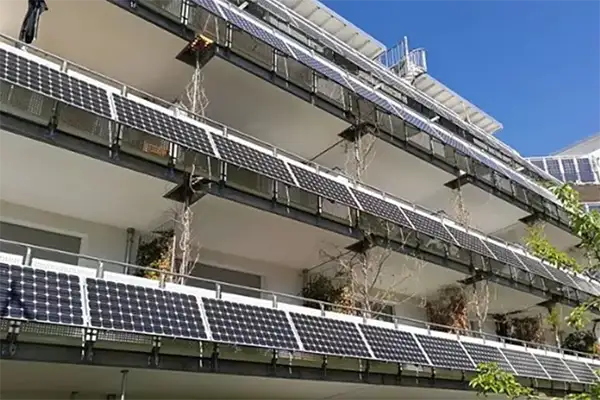
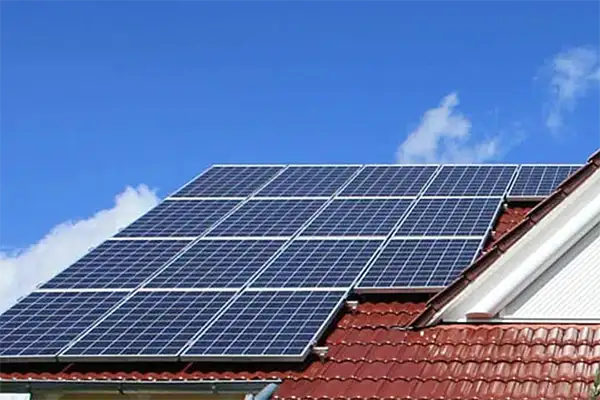
Micro inverter Rooftop Solutions
Discover the untapped potential of solar power and become a vital asset in facilitating the expansion of your business.
FAQ about Micro Inverter
A micro inverter converts DC into AC. In simple terms, it converts the energy your solar panels create into the same type of energy needed to power your lights and home appliances.
Most modern micro inverters come with a warranty of 25 years, matching the lifespan of most modern solar panels.
There are several benefits of choosing a micro inverter over a traditional inverter, including:
- Microinverters ensure that you’re getting the maximum amount of power from each of your panels.
- Microinverters have a longer lifespan.
- Microinverters have panel-level monitoring, so you know how much power your panels are producing.
- Microinverters don’t have sizing restrictions.
- Microinverters are easy to install.
- Micro inverters are more expensive than string inverters.
- Less suitable for battery backup systems
- More technology on your roof
Step 1. Connect the solar panel array to the junction box
Step 2. Wire the disconnect switch
Step 3. Connecting Facility Wiring – PV Feeder Circuit Breaker
Step 4. Wire the PV panels and micro inverters and start the system
Collaborate with Us to Create a Distinct Impact in Your Market
Get A Free Quote
You will get:
- Full catalogue of our micro inverters
- A free quote based on your need
- Free samples after evaluation
- Technical support from our experts
- Sales service from start to finish
- We will contact you within 24 hours
- Don’t worry, we hate spam too!
Powered by HIITIO | Privacy Policy | Cookie Policy



